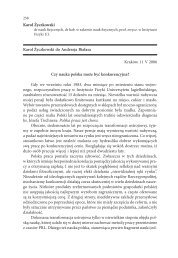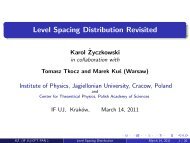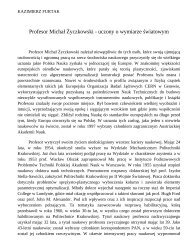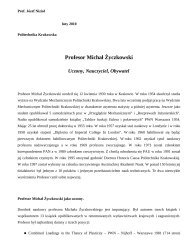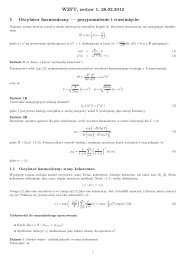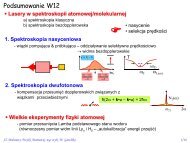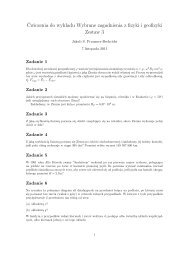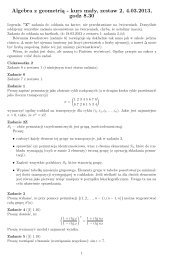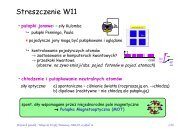WŁADYSŁAW EGNER I got to know professor Michał Życzkowski in ...
WŁADYSŁAW EGNER I got to know professor Michał Życzkowski in ...
WŁADYSŁAW EGNER I got to know professor Michał Życzkowski in ...
You also want an ePaper? Increase the reach of your titles
YUMPU automatically turns print PDFs into web optimized ePapers that Google loves.
<strong>WŁADYSŁAW</strong> <strong>EGNER</strong><br />
I <strong>got</strong> <strong>to</strong> <strong>know</strong> <strong>professor</strong> <strong>Michał</strong> <strong>Życzkowski</strong> <strong>in</strong> 1986, when I was a<br />
freshmen at the Faculty of Mechanical Eng<strong>in</strong>eer<strong>in</strong>g of the Cracow University of<br />
Technology. The <strong>professor</strong> <strong>in</strong>troduced himself as the tu<strong>to</strong>r of the applied<br />
mechanics specialization.<br />
In 1990, I attended <strong>professor</strong> <strong>Życzkowski</strong>’s classes on “Stability and<br />
Optimization". It was a difficult monographic lecture with a large number of<br />
quotations. Already at that time, I was as<strong>to</strong>unded by the <strong>professor</strong>’s <strong>know</strong>ledge<br />
of names of authors and dates of various publications. Anyway, later on, dur<strong>in</strong>g<br />
conferences, I witnessed many times the admiration <strong>in</strong>spired by this <strong>know</strong>ledge.<br />
From these lectures, I also remember summaries of lectures <strong>in</strong> English – an<br />
uncommon practice at that time.<br />
After defend<strong>in</strong>g my Master’s thesis <strong>in</strong> 1991, I started <strong>to</strong> work as an<br />
assistant lecturer at the Unit of Mechanics of Deformable Bodies <strong>in</strong> the Institute<br />
of Mechanics and Mach<strong>in</strong>e Construction. Professor <strong>Życzkowski</strong> almost<br />
immediately engaged me <strong>in</strong> the scientific research he was carry<strong>in</strong>g out at the<br />
time. These were works related <strong>to</strong> the optimum shape of structures undergo<strong>in</strong>g<br />
<strong>to</strong>tal soften<strong>in</strong>g at the stage of destruction. Later on, I was worked on this subject<br />
area for many years and my doc<strong>to</strong>ral dissertation – written under the supervision<br />
of the <strong>professor</strong> – referred <strong>to</strong> it.<br />
Scientific work with <strong>professor</strong> <strong>Życzkowski</strong> <strong>in</strong>volved constant aid on the<br />
part of the <strong>professor</strong>, consist<strong>in</strong>g <strong>in</strong> very frequent meet<strong>in</strong>gs and suggestions<br />
concern<strong>in</strong>g the directions of further works. I was always fasc<strong>in</strong>ated by the<br />
<strong>professor</strong>’s conviction that an analysed issue has a solution that can be found.<br />
For it was not that obvious as the problems we were deal<strong>in</strong>g with were solved<br />
analytically.<br />
I am the last (twenty n<strong>in</strong>th) doc<strong>to</strong>r promoted by the <strong>professor</strong>. Dur<strong>in</strong>g<br />
graduation ceremonies for the doc<strong>to</strong>ral degrees, the vice-chancellor of the<br />
Cracow University of Technology – while read<strong>in</strong>g the name of the supervisor of<br />
my thesis and m<strong>in</strong>e – called him a ”Tu<strong>to</strong>r of Young People”, as if <strong>to</strong> sum up the<br />
<strong>professor</strong>’s activity <strong>in</strong> this doma<strong>in</strong>. This became embedded <strong>in</strong> my memory for<br />
the follow<strong>in</strong>g years and it seems <strong>to</strong> convey well the <strong>professor</strong>’s attitude <strong>to</strong>wards<br />
young scientists. He was <strong>in</strong> fact a tu<strong>to</strong>r of young research personnel.<br />
The <strong>professor</strong> also as<strong>to</strong>nished with his skill of perform<strong>in</strong>g complex<br />
calculations. He often wrote, after a moment’s thought, an equation that was <strong>to</strong><br />
reflect some impromptu assumptions. The, he suggested we should verify it <strong>in</strong><br />
writ<strong>in</strong>g, which required quite some time, while the f<strong>in</strong>al result was identical as<br />
the equation predicted by the <strong>professor</strong>.<br />
Every Tuesday at 11 a.m., the <strong>professor</strong> held a sem<strong>in</strong>ar, <strong>to</strong> which he often<br />
<strong>in</strong>vited lecturers from outside of the Institute. Lecturers present<strong>in</strong>g their future<br />
doc<strong>to</strong>ral or postdoc<strong>to</strong>ral dissertations were also <strong>in</strong>vited <strong>to</strong> the sem<strong>in</strong>ar that was<br />
obliga<strong>to</strong>ry for the fifth year students of applied mechanics (later renamed <strong>to</strong>
computational mechanics). Almost always, the <strong>professor</strong> suggested <strong>to</strong> lecturers<br />
at least several different titles on the relevant subject that he usually quoted from<br />
memory and <strong>in</strong>dicated those he had <strong>in</strong> his library and those that can be borrowed<br />
from the university library.<br />
Professor <strong>Życzkowski</strong> marked out the path of my research career and he<br />
was a true Master for me. He was not only a very respected scientist. He had an<br />
exceptional gift of shar<strong>in</strong>g his <strong>know</strong>ledge and ideas with others. His departure<br />
from among us left a huge gap not only <strong>in</strong> the doma<strong>in</strong> of scientific research.<br />
Dr Władysław Egner<br />
Cracow University of Technology






